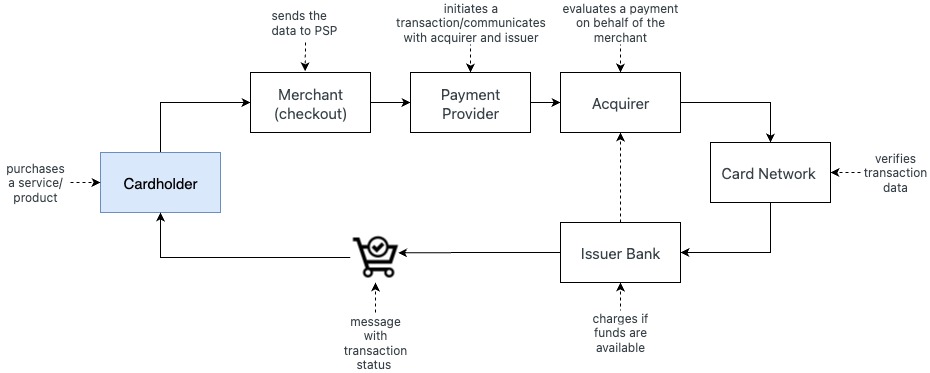💸 Payments
Transform how you manage and process Payments.
Introduction to Payments
A payment flow refers to the end-to-end process that a payment undergoes from initiation to completion. This flow includes several steps involving interactions between the Customer, the business, and various Payment Service Providers.
When a Customer makes a purchase using a credit card, the payment undergoes a series of scenarios:

| Participant | Scenario |
| Cardholder | The individual or entity → initiates the payment by purchasing a service or product. |
| Merchant | The business representative or a service provider → receives the funds once the payment is processed. |
| Payment Service Provider (PSP) | The third-party company → cooperates with acquiring banks and card networks to allow merchants to accept payments. |
| Acquirer | The financial institution or payment processor → evaluates payments on behalf of the Merchant and transmits them via the Card Network to the Issuing bank. |
| Card Network | The organisation → facilitates communication between the Issuer and Acquirer to process card transactions and ensures compliance with payment standards. |
| Issuer bank | The bank → issues the credit card to the consumer on behalf of Card Networks. The Issuer bank is responsible for authorising and ensuring the funds are available for the transaction. |
Payment Request & Commit & Transaction
Payment Request
The highest-level entity in the payment gateway. It was created to reflect the payment in the Merchant’s system. Only Merchants can generate a Payment request. It is the initial step in the payment process and includes all the necessary details required to process the payment, such as:
- Payment amount
- Customer context fields (e.g., shipping details, billing details, etc.)
- Merchant details
- Transaction metadata (e.g., order ID, description)
To review the Payment Request statuses, go to the Statuses & Resolutions guide.
Payment Commit
The operation that reflects the Customer’s payment action and contains the Method itself and the Method fields selected by the Customer.
Payment Commit typically refers to finalising and recording a transaction. This step ensures the payment is confirmed and the funds are allocated accordingly. The commit step makes the payment irreversible and ensures that the funds are designated for the Merchant.
To review the Payment Commit statuses, go to the Statuses & Resolutions guide.
Payment Transaction
The entity that reflects the payment on the Provider side. Its main task is to control the payment process by checking the sequence of payment commands on the Provider and status transitions.
A Transaction encompasses the entire payment process, from the initial Payment Request to the final settlement of funds. It includes all intermediary steps and interactions between the Payer, Merchant, and Payment processor.
To review the Payment Transaction statuses, go to the Statuses & Resolutions guide.
Payment types overview
- Payments via API
- Manual payments are initiated manually on our Dashboard when a Merchant creates a Payment Request.
- Refund payments encompass the process of returning funds to a Customer after a purchase has been made. It typically occurs when a Customer returns a product, cancels a service, or has an error in the transaction. It presupposes a Refund attempt for a Payment Commit. To learn more, go to the Refunds guide.
- Dispute payments encompass managing and resolving disputes that arise when a Customer contests a charge on their account. It typically involves a Customer claiming that a transaction was unauthorised, incorrect, or did not meet their expectations.
Updated about 1 month ago
